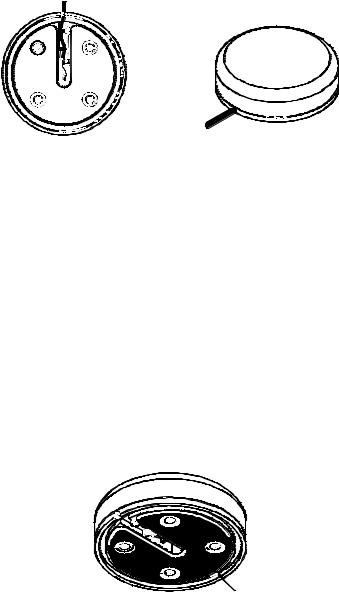Lowrance LGC-2000 User Manual

|
Pub. 988-0147-981 |
|
LGC-2000
GPS Module
Installation Instructions
This package contains an LGC-2000 GPS antenna/receiver module with the parts needed for mounting the module on a flat surface or pole. An optional magnet is available for temporary mounting on any ferrous metal surface.
This module is compatible with any NMEA 2000 ready blue connector Lowrance® unit.
Tools required for installation are: wire pliers, flat screwdriver, drill, 1" (25 mm) drill bit and 3/16" (4.75 mm) drill bit.
The LGC-2000 GPS module contains a 12-parallel channel GPS receiver. The LGC-2000 attaches directly to Lowrance products that display GPS position information. It has a blue connector on the end of the cable.
The LGC-2000 requires 9 to 20 volts DC power. It draws power through the unit or from the NMEA 2000 buss (see unit manual for instructions on powering a NMEA 2000 buss).
The GPS module can be mounted on any flat surface, provided there is access behind the mounting surface for the screws. The optional magnet allows the module to be easily used on cars or off-road vehicles. The pole mount adapter lets you mount the antenna on a pole or swivel mount that uses standard marine 1" - 14 threads.
A 25-foot (7.62 m) Y-adapter extension cable is supplied with the LGC2000. The extension cable has a male connector on both ends. This is to prevent the user from plugging the LGC-2000 directly into the unit.
GPS MODULE INSTALLATION Surface Mount
The GPS module can be easily installed on any flat surface that is at least 3-1/2" (90 mm) wide. Be sure that a clear, unobstructed view of the sky is available at the selected location. GPS signals travel "line-of- sight" at very high frequencies, so nearly anything blocking the antenna can stop the unit from finding a satellite. Caution: Do not mount in line with a radar antenna. Radar radiates high-energy signals that can interfere with GPS signal reception.
In an automobile, you may achieve good results by simply placing the external antenna on the top of the dash, at the base of the windshield. A piece of the rubber non-skid shelf liner material available in recreational
1

vehicle supply stores will help hold the antenna in place. This may not work well if you have a cab-over design pickup truck camper or motor home. If dashboard reception is poor, simply relocate the antenna module elsewhere on the vehicle for a clearer view of the sky.
LGC-2000 Module, bottom view (left) and top view (right).
Once you’ve determined the mounting location, use the template on page 3 to drill the screw holes. The screws supplied with this unit are about 1-1/8" long (4mm x 30mm). Drill 3/16" (4.75 mm) holes for the mounting screws.
If you need to route the cable through the mounting surface, drill a 1" (25mm) hole for the cable's connector. There is a notch in the antenna housing that allows the cable to pass through to the outside, if desired, instead of routing it through the mounting surface.
After drilling the holes, pass the O-ring over the cable and press it into the groove on the bottom of the antenna housing. Now attach the antenna to the mounting surface, using 4mm screws and the supplied lock washers. Route the cable and the GPS module installation is finished.
Magnet Mount
A magnet (available as an option) lets you temporarily mount the GPS module on any ferrous metal surface, such as a car. To use the magnet, simply peel the backing off the magnet's adhesive coating and press the magnet to the bottom of the antenna housing. The module is ready for use.
Magnet
Under side view showing magnet.
2
